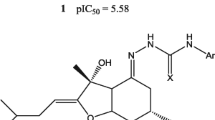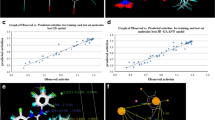Abstract
The interaction mechanism of triazolyl substituted tetrahydrobenzofuran derivatives (compound 1 (N, N-Dipropyl-1-(2-phenyl-4,5,6,7-tetrahydrobenzofuran-4-yl)-1H-1,2,3-triazole-4-methanamine) and 2 (1-(2-Phenyl-4,5,6,7-tetrahydrobenzofuran-4-yl)-4-(morpholin-4-ylmethyl)-1H-1,2,3-triazole)) with H+,K+-ATPase at different pH were studied by induced-fit docking, QM/MM optimization and MM/GBSA binding free energy calculations of two forms (neutral and protonated form) of compounds. The inhibition activity of compound 1 is measured and almost unchanged at different pH, while the activity of compound 2 increases significantly with pH value decreased. This phenomenon could be explained by their protonated form percentages and the calculated binding free energies of protonated and neutral mixture of compounds at different pH. The binding free energy of protonated form is higher than that of neutral form of compound, and the protonated form could be a powerful inhibitor of H+,K+-ATPase. By the decomposed energy comparisons of residues in binding sites, Asp137 should be the key binding site to protonated form of compound because of the hydrogen bond and electrostatic interactions. These calculation results could help for further rational design of novel H+,K+-ATPase inhibitors.








Similar content being viewed by others
References
Li H, Meng L, Liu F, Wei JF, Wang YQ (2013) H+/K+-ATPase inhibitors: a patent review. Expert Opin Ther Pat 23:99–111
Jain KS, Shah AK, Bariwal J, Shelke SM, Kale AP et al (2007) Recent advances in proton pump inhibitors and management of acid-peptic disorders. Bioorg Med Chem 15:1181–1205
Shin JM, Munson K, Vagin O, Sachs G (2009) The gastric HK-ATPase: structure, function, and inhibition. Pflug Arch Eur J Physiol 457:609–622
Lee J, Simpson G, Scholes P (1974) An ATPase from dog gastric mucosa: changes of outer pH in suspensions of membrane vesicles accompanying ATP hydrolysis. Biochem Biophys Res Commun 60:825–832
Wolosin JM (1985) Ion transport studies with H+/K+-ATPase-rich vesicles: implications for HCl secretion and parietal cell physiology. Am J Physiol 248:G595–G607
Shin JM, Sachs G (2006) Gastric H, K-ATPase as a drug target. Dig Dis Sci 51:823–833
Andersson K, Carlsson E (2005) Potassium-competitive acid blockade: a new therapeutic strategy in acid-related diseases. Pharmacol Ther 108:294–307
Sachs G, Shin JM, Vagin O, Lambrecht N, Yakubov I et al (2007) The gastric H, K-ATPase as a drug target: past, present, and future. J Clin Gastroenterol 41:S226–S242
Sachs G, Shin JM, Howden CW (2006) The clinical pharmacology of proton pump inhibitors. Aliment Pharmacol Ther 23:S2–S8
Lee JW, Chae JS, Kim CS, Kim JK, Lim DS et al (1998) Pyrimidine derivatives and processes for the preparation thereof. US005750531A
Li W, Yang Y, Tian Y, Xu X, Chen Y et al (2011) Preparation and in vitro/in vivo evaluation of revaprazan hydrochloride nanosuspension. Int J Pharm 408:157–162
Fang HB, Jin L, Huang NY, Wang JZ, Zou K et al (2013) Synthesis, structure and H+/K+-ATPase inhibitory activity of novel triazolyl substituted tetrahydrobenzofuran derivatives via one-pot three-component click reaction. Chin J Chem 31:831–838
Abe K, Tani K, Nishizawa T, Fujiyoshi Y (2009) Inter-subunit interaction of gastric H+,K+-ATPase prevents reverse reaction of the transport cycle. EMBO J 28:1637–1643
Abe K, Tani K, Fujiyoshi Y (2011) Conformational rearrangement of gastric H+,K+-ATPase induced by an acid suppressant. Nat Commun 2:155–160
Kim CG, Watts JA, Watts A (2005) Ligand docking in the gastric H+/K+-ATPase: homology modeling of reversible Inhibitor binding sites. J Med Chem 48:7145–7152
Berman HM, Westbrook J, Feng Z, Gilliland G, Bhat TN et al (2000) The protein data bank. Nucleic Acids Res 28:235–242
Shinoda T, Ogawa H, Cornelius F, Toyoshima C (2009) Crystal structure of the sodium-potassium pump at 2.4 Å resolution. Nature 459:446–450
Altschul SF, Madden TL, Schaffer AA, Zhang J, Zhang Z et al (1997) Gapped BLAST and PSI-BLAST: a new generation of protein database search programs. Nucleic Acids Res 25:3389–3402
Chenna R, Sugawara H, Koike T, Lopez R, Gibson TJ et al (2003) Multiple sequence alignment with the clustal series of programs. Nucleic Acids Res 31:3497–3500
Sali A, Blundell TL (1993) Comparative protein modelling by satisfaction of spatial sestraints. J Mol Biol 234:779–815
Schrödinger, LLC, New York (2010). www.schrodinger.com
Jorgensen WL, Maxwell DS, Tirado-Rives J (1996) Development and testing of the OPLS all-atom force field on conformational energetics and properties of organic liquids. J Am Chem Soc 118:11225–11236
Laskowski RA, MacArthur MW, Moss DS, Thomton JM (1993) PROCHECK: a program to check the stereochemical quality of protein structures. J Appl Crystallogr 26:283–291
LigPrep, version 2.4, Schrödinger, LLC, New York, NY (2010)
Shelley JC, Cholleti A, Frye L, Greenwood JR, Timlin MR et al (2007) Epik: a software program for pKa prediction and protonation state generation for drug-like molecules. J Comput Aided Mol Des 21:681–691
Sherman W, Day T, Jacobson MP, Friesner RA, Farid R (2006) Novel procedure for modeling ligand/receptor induced fit effects. J Med Chem 49:534–553
Zhong H, Tran LM, Stang JL (2009) Induced-fit docking studies of the active and inactive states of protein tyrosine kinases. J Mol Graph Model 28:336–346
Wanga H, Aslanian R, Madison VS (2008) Induced-fit docking of mometasone furoate and further evidence for glucocorticoid receptor 17α pocket flexibility. J Mol Graph Model 27:512–521
Luo HJ, Wang JZ, Deng WQ, Zou K (2013) Induced-fit docking and binding free energy calculation on furostanol saponins from Tupistra chinensis as epidermal growth factor receptor inhibitors. Med Chem Res 22:4970–4979
Glide, version 5.6, Schrödinger, LLC, New York, NY (2010)
Friesner RA, Murphy RB, Repasky MP, Frye LL, Greenwood JR et al (2006) Extra precision glide: docking and scoring incorporating a model of hydrophobic enclosure for protein-ligand complexes. J Med Chem 49:6177–6196
Vagin O, Denevich S, Munson K, Sachs G (2002) SCH 28080, a K+-competitive inhibitor of the gastric H, K-ATPase, binds near the M5-6 luminal loop, preventing K+ access to the ion binding domain. Biochemistry 41:12755–12762
Munson K, Gutierrez C, Balaji VN, Ramnarayan K, Sachs G (1991) Identification of an extracytoplasmic region of H+,K+-ATPase labeled by a K+-competitive photoaffinity inhibitor. J Biol Chem 266:18976–18988
Asano S, Matsuda S, Tega Y, Shimizu K, Sakamoto S et al (1997) Mutational analysis of putative SCH28080 binding sites of the gastric H+,K+-ATPase. J Biol Chem 272:17668–17674
Vagin O, Munson K, Lambrecht N, Karlish SJD, Sachs G (2000) Mutational analysis of the K+-competitive inhibitor site of gastric H, K-ATPase. Biochemistry 40:7480–7490
Munson K, Law RJ, Sachs G (2007) Analysis of the gastric H, K-ATPase for ion pathways and inhibitor binding sites. Biochemistry 46:5398–5417
Jacobson MP, Pincus DL, Rapp CS, Day TJF, Honig B et al (2004) A hierarchical approach to all-atom protein loop prediction. Proteins 55:351–367
Murphy RB, Philipp DM, Friesner RA (2000) A mixed quantum mechanics/molecular mechanics (QM/MM) method for large-scale modeling of chemistry in protein environments. J Comp Chem 21:1442–1457
Philipp DM, Friesner RA (1999) Mixed ab initio QM/MM modeling using frozen orbitals and tests with alanine dipeptide and tetrapeptide. J Comp Chem 20:1468–1494
Kollman PA, Massova I, Reyes C, Kuhn B, Huo S et al (2011) Calculating structures and free energies of complex molecules: combining molecular mechanics and continuum models. Acc Chem Res 33:889–897
Massova I, Kollman PA (2000) Combined molecular mechanical and continuum solvent approach (MM–PBSA/GBSA) to predict ligand binding. Perspect Drug Discov Des 18:113–135
MacroModel, version 9.8, Schrödinger, LLC, New York, NY (2010)
Saccomani G, Stewart HB, Show D, Lewin M, Sachs G (1977) Characterization of gastric mucosal membranes. Biochem Biophys Acta 465:311–330
Yoon YA, Park CS, Cha MH, Choi H, Simm JY et al (2010) Novel pyrimidines as acid pump antagonists (APAs). Bioorg Med Chem Lett 20:5735–5738
ACD/I-Lab, version 12.01 (2013) Advanced Chemistry Development, Inc., Toronto. www.acdlabs.com
Maestro, version 9.3, Schrödinger, LLC, New York, NY (2012)
Acknowledgments
This work was supported by Natural Science Foundation of Hubei Province in China (No. 2014CFB684).
Author information
Authors and Affiliations
Corresponding author
Rights and permissions
About this article
Cite this article
Luo, HJ., Wang, JZ., Huang, NY. et al. Computational insights into the interaction mechanism of triazolyl substituted tetrahydrobenzofuran derivatives with H+,K+-ATPase at different pH. J Comput Aided Mol Des 30, 27–37 (2016). https://doi.org/10.1007/s10822-015-9886-8
Received:
Accepted:
Published:
Issue Date:
DOI: https://doi.org/10.1007/s10822-015-9886-8




